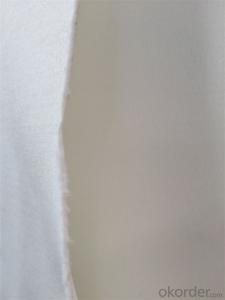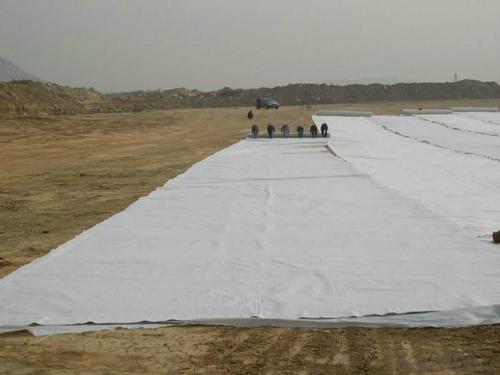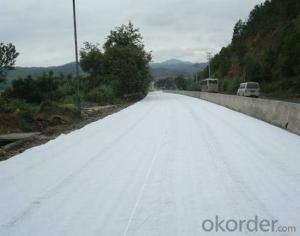Pot Géotextile Non Woven Geotextile for 1200g Short Fiber
- Loading Port:
- Qingdao
- Payment Terms:
- TT OR LC
- Min Order Qty:
- 10000 m²
- Supply Capability:
- 100000 m²/month
OKorder Service Pledge
OKorder Financial Service
You Might Also Like
Non Woven Geotextile with Short Fiber Needle Punched, Find Details about Non Woven Geotextile with Short Fiber Needle Punched and Make an Inquiry for Geotextile at OKorder.com.
Geotextile Introduction
Geotextile, made from PP or PET, has excellent permeability, acquired, durability, which can be widely used in railway ,highway, movement hall,Dams,hydraulic structures hence hole, coastal shoal, reclamation,environmental protection and other projects.

Geotextile Specification
1. Weight: 100g~1500g
2. Width: 1m ~ 7m

Geotextile Package:
Packing: Plastic film inside & Woven bag outside.
Shipping: About 15 days after receipt the deposit

Geotextile Application
Filtration
Separation
Adding
Protection



FAQ:
Q: What kind of payments does jenor support?
A: T/T, L/C, Cash are accepted.
Q: Do you charge for the samples?
A: Accordeing to our company policy, the samples are freee, we only charge the freight fee. And we will return the freight fee during the next order.
Q: Can you produce according to customers' design?
A: Sure, we are professional manufacturer, OEM and ODM are both welcome.
Q: Do you have other products?
A: Yes, please check the pictures:
If you want to find more details about the non-woven geotextile, you could make an Inquiry in okorder.com. Okorder.com provides you the products with best price and quality!
- Q: The properties of woven geotextiles
- Product features: 1, with a reinforcement function: to stabilize the project in the course of prolonged use of the transfer occurred, and can be the role of the soil in the local stress transmission or assigned to a larger area. 2, with the role of separation: woven geotextile with different geotechnical structure to form a stable interface, in accordance with the requirements to play their own characteristics and the overall role. 3, the role of drainage filter: allow moisture to block the loss of sand particles, in the drainage of geotextiles on the poor water in the soil can play the water along the geotextile quickly discharged the purpose. 4, the geotextile and geomembrane used in two different pressures between the material can play a role in tension diaphragm. 5, with a block function: the geotextile placed in the flow of liquid with suspended particles in the channel to organize fine mud particles, and allow the liquid through the function. 6, play the role of cushion mat: the geotextile placed on the slope can prevent the soil particles due to the erosion of rain and the loss or planting turf.
- Q: How do geotextiles assist in slope stabilization?
- Geotextiles assist in slope stabilization by providing reinforcement and erosion control. They are placed on slopes to prevent soil erosion, hold the soil in place, and increase its stability. The geotextiles act as a barrier, allowing water to pass through while retaining the soil particles, which prevents soil loss and slope failure. Additionally, the geotextiles distribute the load evenly across the slope, reducing the pressure on the soil and increasing its resistance to movement.
- Q: Are geotextiles suitable for use in drainage ditches?
- Yes, geotextiles are suitable for use in drainage ditches. Geotextiles are often used to enhance the performance of drainage systems by providing filtration, separation, and reinforcement. They can help prevent soil erosion, retain fine particles, and improve water flow, making them an effective solution for drainage ditch applications.
- Q: Sng400-2.5gb / t-1998 geotextile is what the specifications
- SNG400-2.5 refers to the national standard polyester staple acupuncture non-woven geotextile 400g / ㎡, width 2.5m. The standard code for the GB / T-1998 staple fiber nonwoven geotextile is generally the SNG / (1) (2) / (3) - (4) / (5). (1) that the use of raw materials fiber code: PET-polyester, PP-polypropylene, PA-nylon, PV-vinylon, PE-Ethylene (conventional polyester are generally vacant omitted code) (2) that polyester staple fiber non-woven Geotextile per unit area weight. (3) that the composite products in the polyester staple fiber non-woven geotextile weight per unit area, non-composite product vacancies. (4) width, expressed in meters (5) production department number: can express the product more specific characteristics, functions, varieties, sequences, etc., the general vacancy. For example, 2.5m wide 400g / ㎡ polyester staple fiber non-woven geotextile representation of the method can be SNG / PET400-2.5, can also be expressed as SNG400-2.5
- Q: What are the advantages of using geotextiles in shoreline stabilization projects?
- There are several advantages of using geotextiles in shoreline stabilization projects. Firstly, geotextiles provide effective erosion control by preventing the loss of sediments and soil particles from the shoreline. This helps to maintain the stability and integrity of the shoreline, reducing the risk of damage to nearby infrastructure and habitats. Secondly, geotextiles act as a filter, allowing water to pass through while retaining soil particles. This helps to improve water quality by reducing sediment runoff and the associated pollution. Additionally, geotextiles are durable and long-lasting, making them a cost-effective solution for shoreline stabilization. They are resistant to degradation from UV exposure, chemicals, and biological factors, ensuring their effectiveness over an extended period. Furthermore, geotextiles are flexible and easy to install, making them suitable for a variety of shoreline environments. They can be customized to fit specific project requirements, providing a versatile option for different shoreline stabilization needs. Overall, the use of geotextiles in shoreline stabilization projects offers numerous advantages, including erosion control, improved water quality, cost-effectiveness, durability, and ease of installation.
- Q: Are geotextiles resistant to UV radiation?
- Yes, geotextiles are typically designed to be resistant to UV radiation. They are often made from materials that have UV stabilizers or are treated with UV-resistant coatings, ensuring their durability and longevity when exposed to sunlight.
- Q: Can geotextiles be used in the construction of artificial ponds?
- Yes, geotextiles can be used in the construction of artificial ponds. Geotextiles are commonly used as a lining material to provide stability, prevent erosion, and control water flow in various construction projects, including artificial ponds. They can help to separate different soil layers, reinforce the pond walls, and provide a barrier to prevent water leakage.
- Q: Geotextile cloth how many square feet
- Geotextile laying - including the labor costs (according to geotextile specifications and laying conditions and requirements are different), material costs (specific quality requirements and thickness, are not the same ..), mechanical use costs (such as transport, sewing System, hoisting, etc.). The price is different. Sometimes the construction of our geotextile laying, the price per square meter from 9 yuan to 50 yuan range.
- Q: The secondary lining of the tunnel to install the vertical ring to the blind tube hang the geotextile waterproof board generally used for how long
- See the progress of the project
- Q: What are the common problems encountered during geotextile installation?
- Some common problems encountered during geotextile installation include improper placement or alignment of the geotextile, inadequate anchoring or securing of the material, damage or tears during installation, poor soil preparation, and inadequate or improper selection of geotextile material for the specific application.
Send your message to us
Pot Géotextile Non Woven Geotextile for 1200g Short Fiber
- Loading Port:
- Qingdao
- Payment Terms:
- TT OR LC
- Min Order Qty:
- 10000 m²
- Supply Capability:
- 100000 m²/month
OKorder Service Pledge
OKorder Financial Service
Similar products
Hot products
Hot Searches
Related keywords
































